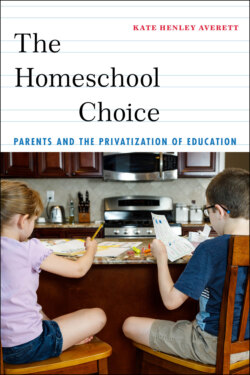Читать книгу The Homeschool Choice - Kate Henley Averett - Страница 16
The Emergence of the Modern Homeschooling Movement
ОглавлениеThough the homeschooling movement’s growth is largely credited to the practice being taken up by fundamentalist Christians, the movement itself originated in the work of progressive education reformers, most notably John Holt.4 Holt, a public school teacher who had grown disillusioned with the school system, published several notable works in the 1960s that scrutinized public schools and promoted the idea of “deschooling,” or letting children learn apart from institutionalized schools.5 These progressive reformers believed that education should be flexible and should cater to the needs of the individual child—something they did not see happening in public schools. They were also concerned that public schools ended up quashing children’s innate curiosity, and argued that children would learn most of what they need to know if left in charge of their own education. This critique was part of a larger critique in the 1960s of institutions in general, which many on the Left saw as being conservative, overly bureaucratic, and designed to maintain the status quo of racial, gender, and class inequalities. In this vein, education reformers argued that schools were preparing students for routinized, industrial careers rather than to be independent thinkers.6 This system may have served the interests of elites, but, education reformers argued, it certainly did not serve the interests of most children.
At around the same time, homeschooling also began to be advocated and practiced by some in the religious Right. Seventh Day Adventists Raymond and Dorothy Moore are generally credited with being the first conservative Christians in the United States to publicly advocate for homeschooling. The Moores were critical both of the secular nature of education and of the way a formal curriculum was being pushed onto children at younger and younger ages.7 They became frequent guests on James Dobson’s Focus on the Family radio show, and Dobson’s endorsement of homeschooling is credited with its rapid growth among conservative Evangelical Christians.8
For many conservative Christians, homeschooling was a way for their families to resist what they saw as the increasing encroachment of secular culture into their—and their children’s—lives.9 The US Supreme Court rulings in the early 1960s that ended the practices of school prayer and Bible reading in public schools played an important role in catalyzing the religious Right against public schools (and continue, to this day, to motivate some parents—more than a few of the parents I interviewed brought up the end of school prayer as an important turning point in what they saw as the downward spiral of American public education).10 Some research has also suggested that school desegregation played a role in the rise of homeschooling among the religious Right, and that early Christian homeschooling can be understood as a form of “white flight” from integrated school districts.11
In the early decades of the modern homeschooling movement, there was a fair amount of cooperation between progressives and conservative religious homeschoolers. While they had somewhat different motivations for advocating homeschooling, movement leaders such as John Holt, on the left, and Raymond and Dorothy Moore, on the right, had in common their belief in the importance of child-centered pedagogical approaches.12 However, historians of the movement argue that, as the religious Right gained broad political momentum and an increasing number of conservative Protestants took up the practice of homeschooling in the 1980s, religious homeschoolers increasingly critiqued these pedagogical approaches, and thus began distancing themselves from the secular wing of the homeschooling movement.13 Scholars point to the founding in 1983 of the Home School Legal Defense Association (HSLDA), an explicitly (fundamentalist) Christian organization, as one of the pivotal moments in the eventual division of the movement.14 This trend away from cooperation between the two wings was further cemented by the legislative success of the movement.
